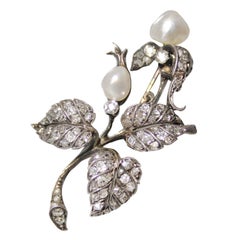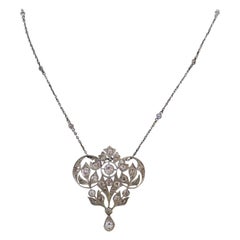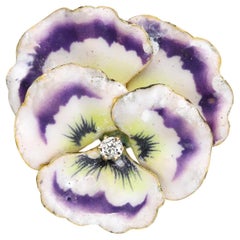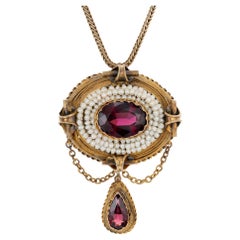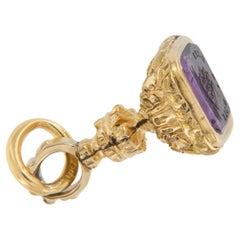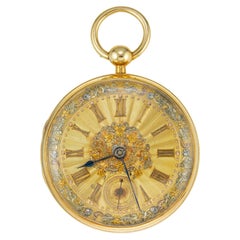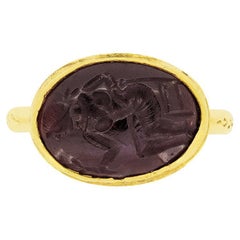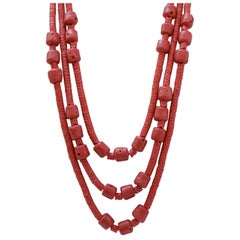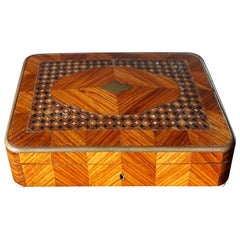Antique Jewelry 1800S
Late 19th Century Victorian Antique Jewelry 1800S
Diamond, Natural Pearl, Gold Plate
Late 19th Century Unknown Edwardian Antique Jewelry 1800S
Diamond, Yellow Gold, Platinum
1890s French Antique Jewelry 1800S
Diamond, 14k Gold, Enamel
Early 19th Century Antique Jewelry 1800S
Garnet, Pearl, Natural Pearl, 14k Gold, Yellow Gold, Gold
Early 19th Century American Georgian Antique Jewelry 1800S
Amethyst, Gold, Mixed Metal
Early 19th Century Antique Jewelry 1800S
Gold, 18k Gold, Rose Gold, White Gold, Yellow Gold
Early 1800s British Georgian Antique Jewelry 1800S
Garnet, 18k Gold, Yellow Gold
Early 1800s Italian Retro Antique Jewelry 1800S
Coral
19th Century French Napoleon III Antique Jewelry 1800S
Brass
Late 19th Century European Victorian Antique Jewelry 1800S
Silver
1880s European Victorian Antique Jewelry 1800S
Diamond, Yellow Gold
Mid-19th Century Austrian Renaissance Revival Antique Jewelry 1800S
Emerald, Garnet, Silver, Enamel
Early 1800s French Art Deco Antique Jewelry 1800S
Late 19th Century Victorian Antique Jewelry 1800S
Mid-19th Century European Early Victorian Antique Jewelry 1800S
Turquoise, Silver
Late 18th Century Dutch Georgian Antique Jewelry 1800S
Silver
1890s Art Nouveau Antique Jewelry 1800S
Diamond, 14k Gold, Yellow Gold, Enamel
Mid-19th Century Unknown Victorian Antique Jewelry 1800S
Late 19th Century English Victorian Antique Jewelry 1800S
Gold Plate, Silver
Early 19th Century Antique Jewelry 1800S
Diamond, Pearl, 18k Gold, Silver
Late 19th Century English Victorian Antique Jewelry 1800S
Diamond, Cultured Pearl, 14k Gold, Yellow Gold
Early 1800s Antique Jewelry 1800S
Gold, Yellow Gold, Enamel
1850s Antique Jewelry 1800S
Diamond, Gold, 18k Gold, Yellow Gold
1890s Victorian Antique Jewelry 1800S
Opal, Yellow Gold, Silver
1850s Unknown Early Victorian Antique Jewelry 1800S
Agate, 14k Gold, Yellow Gold
19th Century Unknown Victorian Antique Jewelry 1800S
Opal, Gold, 14k Gold
1890s European Late Victorian Antique Jewelry 1800S
Diamond, Gold
1870s Unknown Art Nouveau Antique Jewelry 1800S
Diamond, Yellow Gold, Silver
19th Century Unknown Victorian Antique Jewelry 1800S
Coral, 14k Gold, Gold
19th Century Italian Romantic Antique Jewelry 1800S
Coral, Yellow Gold
1880s Unknown Victorian Antique Jewelry 1800S
Pearl, Peridot, Yellow Gold
19th Century European Art Deco Antique Jewelry 1800S
Opal, Emerald, Diamond, Silver, Gold
Early 1800s Russian Neoclassical Antique Jewelry 1800S
Silver
Early 19th Century German Antique Jewelry 1800S
Metal, Berlin Iron
Early 1800s Austrian Aesthetic Movement Antique Jewelry 1800S
Silver
1850s Edwardian Antique Jewelry 1800S
Diamond, Blue Sapphire, Silver
19th Century English Other Antique Jewelry 1800S
Silk, Birdseye Maple, Ebony, Mahogany, Oak
Late 19th Century English Victorian Antique Jewelry 1800S
Garnet, Turquoise, 18k Gold, Gold
1860s British High Victorian Antique Jewelry 1800S
Aluminum
Early 19th Century European Georgian Antique Jewelry 1800S
Pearl, Freshwater Pearl, Gilt Metal, Berlin Iron
Early 1900s American Art Nouveau Antique Jewelry 1800S
Blue Sapphire, 14k Gold, Yellow Gold
Early 1900s American Art Nouveau Antique Jewelry 1800S
Diamond, Ruby, 14k Gold
Early 19th Century Unknown High Victorian Antique Jewelry 1800S
Diamond, White Diamond, Ruby, Yellow Gold
Early 1800s Unknown Victorian Antique Jewelry 1800S
Rock Crystal
Late 19th Century Italian Antique Jewelry 1800S
Pinchbeck
Mid-19th Century Unknown Early Victorian Antique Jewelry 1800S
Natural Pearl, Rose Gold
Late 19th Century Italian Antique Jewelry 1800S
Gold
Early 19th Century British Early Victorian Antique Jewelry 1800S
Pinchbeck
Late 19th Century Italian Art Nouveau Antique Jewelry 1800S
Diamond, Pearl, 18k Gold
17th Century British Georgian Antique Jewelry 1800S
Coral
17th Century Swiss Antique Jewelry 1800S
Pearl, 18k Gold
Late 19th Century Unknown Late Victorian Antique Jewelry 1800S
Gilt Metal
Late 19th Century Spanish Antique Jewelry 1800S
Diamond, Gold, Silver
19th Century British Antique Jewelry 1800S
Late 19th Century Italian Antique Jewelry 1800S
Gold
Late 19th Century Italian Art Deco Antique Jewelry 1800S
Diamond, 18k Gold
Early 19th Century French Empire Antique Jewelry 1800S
Silver, Enamel
Mid-19th Century Italian Antique Jewelry 1800S
Yellow Gold
1850s Unknown Victorian Antique Jewelry 1800S
Diamond, Turquoise, 14k Gold
1850s Unknown Etruscan Revival Antique Jewelry 1800S
Natural Pearl, Silver, Sterling Silver
- 1
Antique Jewelry 1800S For Sale on 1stDibs
How Much are Antique Jewelry 1800S?
- 1stDibs ExpertNovember 2, 2023During the 1800s, necklaces, earrings, brooches and hair accessories were popular jewelry pieces in styles ranging from Georgian with enamel details to Victorian with floral flourishes. The commonly used gemstones of the 19th century included diamonds, emeralds, rubies, sapphires, garnets and amethysts. Gold was the dominant metal for jewelry, but silver became sought-after during the 1880s and 1890s. Explore an assortment of antique jewelry on 1stDibs.
- 1stDibs ExpertMarch 22, 2022In the 1800s, miniatures were small portraits. People commissioned them to give as gifts to their loved ones to carry with them. In this way, miniatures were similar to modern wallet photographs. On 1stDibs, find a range of miniature portraits.
- Were there safes in the 1800s?1 Answer1stDibs ExpertMarch 31, 2023Yes, there were safes in the 1800s. Historical records indicate that by 1820, some companies used safes to protect goods from fire. Following market campaigns in the 1840s, more companies and individuals began to purchase safes as an anti-theft measure. Shop a variety of safes on 1stDibs.
- 1stDibs ExpertFebruary 13, 2023In the 1800s, safes were usually made of metal like tin plating or sheet iron. Fireproofing the safes proved difficult, and during the 1820s, specific mixtures of materials such as mica, potash lye and alum were used to line a safe’s interior in order to prevent its contents from succumbing to fire damage. Shop a collection of safes on 1stDibs.
- 1stDibs ExpertNovember 4, 2024To identify 1800s furniture, first check to see if your piece bears any maker's marks. Should you locate any, researching them using trusted online resources can help you determine the maker and age of your furniture. To determine if unmarked pieces date back to the 19th century, look for tool marks and variations in their carvings and ornamentation. Since 19th-century furniture was handmade, you should expect to find these signs of hand craftsmanship. A piece that shows no marks or inconsistencies in details is likely a contemporary machine-made reproduction. Familiarizing yourself with the characteristics of Rococo, Chippendale, Gothic Revival, neoclassical and other 19th-century styles can also be helpful. If you struggle to make an identification, consider consulting a certified appraiser or knowledgeable antique dealer. On 1stDibs, find a range of 19th-century furniture.
- 1stDibs ExpertJune 30, 2023In the 1800s, nightstands were often called commodes. Prior to the advent of indoor plumbing, early nightstands contained a porcelain chamber pot in a cabinet that provided a convenient and private alternative to visiting the outhouse. Today, antique, new and vintage nightstands, which are pieces of bedroom furniture that are often called bedside tables, are typically low-profile tables that are positioned alongside one’s bed or elsewhere in a bedroom. Shop a selection of nightstands on 1stDibs.
- 1stDibs ExpertApril 5, 2022Yes, pocket watches peaked in popularity in the 1800s. The first pocket watch was created in Germany in 1510, but was originally too large for a pocket. In the 1600s, the design began to get more compact, but for a long time pocket watches were a rarity and a symbol of wealth. Shop an array of antique pocket watches on 1stDibs.
- What is 1800s art called?1 Answer1stDibs ExpertNovember 26, 2024What 1800s art is called depends on its age and style, as the century saw multiple movements. Most art historians refer to art that broke from traditional norms, produced in the 1860s and later, as modern art, and everything that preceded it as pre-modern art. Some of the art styles that were popular during the 19th century include Impressionism, Realism, Romanticism, Neoclassicism, Expressionism and Fauvism. Shop a wide range of 19th-century art on 1stDibs.
- 1stDibs ExpertDecember 4, 2023What wedding rings looked like in the 1800s was similar to other Victorian jewelry. The Victorian era spanned from 1837 to 1901, coinciding with the reign of Queen Victoria in the United Kingdom. At the beginning of this period, rings were made of gold and affordable only to the wealthy. Designs for Victorian-era rings often featured repoussé work and chasing, in which patterns are hammered into the metal. Some featured stones secured by collets, settings similar to bezels, with prongs and a closed back. On 1stDibs, find a selection of Victorian wedding rings.
- 1stDibs ExpertApril 26, 2024To tell if jewelry is antique, look for its hallmarks. You will usually find them in inconspicuous areas, such as on clasps, the backs of pendants or the insides of bracelets and rings. Once you have located the hallmarks, use trusted online resources to identify the maker and find out when they were active. Pieces produced more than 100 years ago are antique. If you need assistance dating a particular piece, enlist the services of a certified appraiser or knowledgeable antiques dealer. Find a large collection of antique jewelry on 1stDibs.
- What is antique paste jewelry?1 Answer1stDibs ExpertOctober 12, 2021Paste jewelry is made out of a special type of flint glass that emulates several gemstones. Paste is a hand-cut glass that is polished with metal powder until it gleams like a gem. Paste jewelry was popular as a cheaper alternative to diamonds during the Georgian, Victorian, and Edwardian eras, as well as the Art Deco period. On 1stDibs, find a variety of antique and vintage paste jewelry.
- 1stDibs ExpertNovember 4, 2024To identify antique jewelry, first try to locate any maker's markings. These may be found in a variety of inconspicuous locations, such as the insides of rings, the clasps of bracelets and chains and the backs of clip-on earrings, pendants and brooches. You can find trustworthy online reference guides that make searching for makers using their hallmarks easy. Once you have determined who produced your jewelry, learn about the creator and estimate approximately when they made your item. If your jewelry is at least 100 years old, it is antique. Alternatively, a certified appraiser or knowledgeable antique dealer can assist in dating your jewelry. Find a wide range of antique jewelry on 1stDibs.
- 1stDibs ExpertApril 5, 2022In the 1700s, popular jewelry types included bracelets, brooches, belt buckles, earrings, rings and necklaces. Additionally, women frequently wore hair jewelry, such as tiaras, hairpins and combs encrusted with precious gemstones. You can find a selection of antique jewelry on 1stDibs.
- 1stDibs ExpertMay 5, 2023In the 1910s, Art Nouveau jewelry was popular. Trends of the time included long necklaces often decorated with tassels and platinum beads. Among gemstones, diamonds and sapphires were in high demand. Find a selection of antique jewelry on 1stDibs.
- What era is 1920s jewelry?1 Answer1stDibs ExpertDecember 4, 2023What era 1920s jewelry is depends on its design. Most people associate this decade with the Art Deco movement, which took inspiration from eclectic sources like Cubism, ancient Egypt and Native American, African and Asian motifs. However, some pieces produced during the 1920s are more in line with the style trends of earlier periods, such as Art Nouveau, Edwardian and Victorian. Explore a diverse assortment of 1920s jewelry on 1stDibs.
- 1stDibs ExpertNovember 6, 2023Jewelry is considered antique once it is 100 years old. Pieces that are 20 to 99 years old are vintage. Contemporary is the term used to describe jewelry that is less than 20 years old. Explore a large selection of antique, vintage and contemporary jewelry from some of the world's top dealers on 1stDibs.
- 1stDibs ExpertDecember 4, 2023To tell if antique jewelry is real, first look for hallmarks that may signify the maker. You can then use trusted online resources to find out what to look for to verify authenticity. If the jewelry doesn't have hallmarks, you may wish to consult a certified appraiser or licensed dealer. An expert can evaluate your jewelry, tell you whether it is a genuine antique and provide information about its materials and approximate value. Explore a large selection of antique jewelry on 1stDibs.
- 1stDibs ExpertMay 5, 2023To know if your antique jewelry is valuable, you can consult trusted online resources to see what similar pieces have sold for in the past. It is important to note that the condition of your specific piece will have a major effect on how much it is worth. Jewelry of a certain historical period will be worth more to collectors than accessories from other less noteworthy eras, and whether or not a given accessory is set with a precious gemstone may affect its value as well. You may wish to have the jewelry evaluated by a certified appraiser who can examine the piece and give you a price estimate. Master jewelry designers and luxury houses of the 19th and 20th centuries include Cartier, Tiffany & Co., Van Cleef & Arpels, BVLGARI and others. Shop a collection of jewelry from some of the world’s top sellers on 1stDibs.
- 1stDibs ExpertDecember 12, 2023To tell if jewelry is vintage or antique, first look for any hallmarks that signify its maker. You can use trusted online resources to research when the maker was active and producing pieces similar to yours to roughly estimate its age. Jewelry is vintage if it's between 20 and 99 years old, and antique if it is 100 years old or more. If you're unable to locate a maker's hallmark, becoming familiar with the materials and other characteristics used during different eras of jewelry can help you date your piece. When in doubt, enlist the help of a certified appraiser or knowledgeable dealer. On 1stDibs, explore a large collection of vintage and antique jewelry.
- 1stDibs ExpertMay 5, 2023Yes, some antique jewelry does go up in value. It is important to note that demand as well as the condition of your specific piece will have a major effect on how much it is worth. A certain historical period’s jewelry may be worth more to collectors than accessories from other less noteworthy eras, and whether or not a given accessory is set with precious gems may affect its value as well. You may wish to have the jewelry evaluated by a certified appraiser who can examine the piece and estimate its value. Master jewelry designers and luxury houses of the 19th and 20th centuries include Cartier, Tiffany & Co., Van Cleef & Arpels, BVLGARI and others. On 1stDibs, shop a large collection of jewelry from some of the world’s top sellers.
